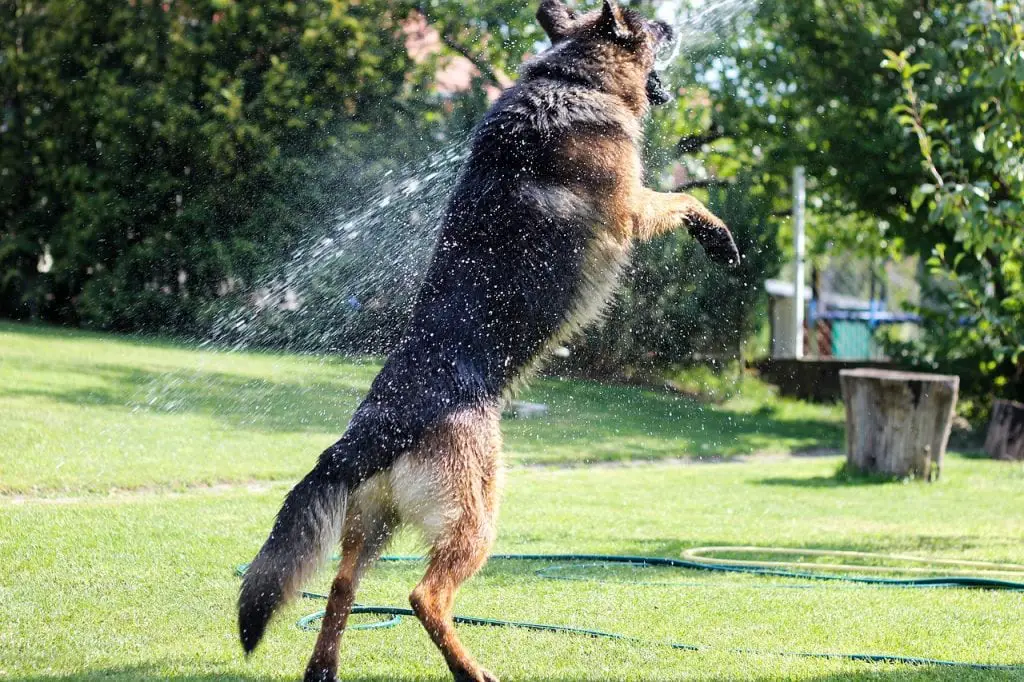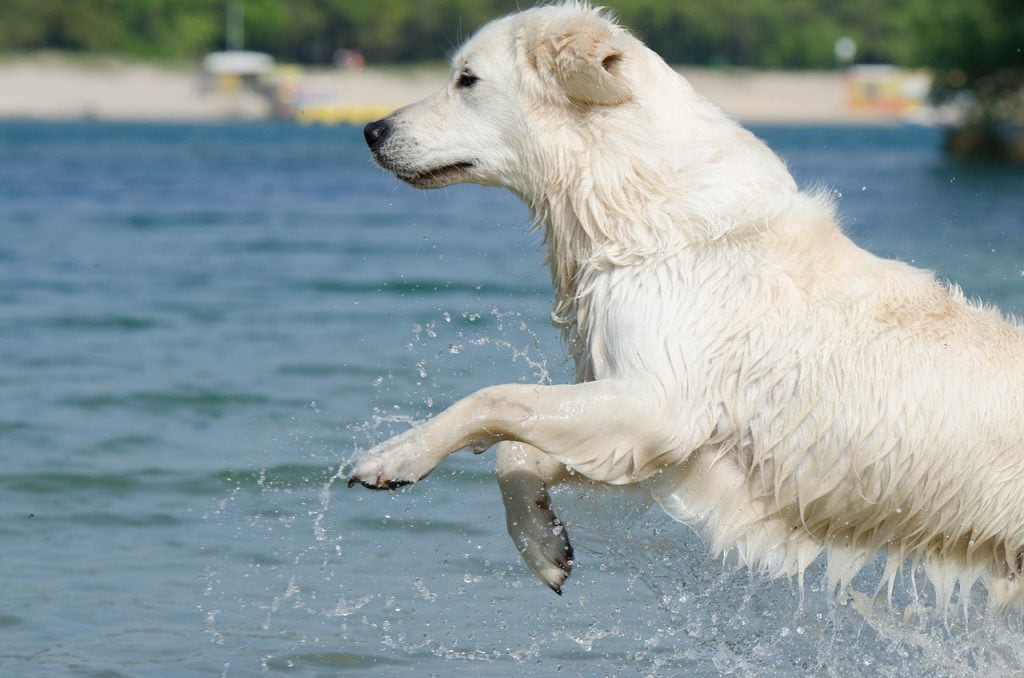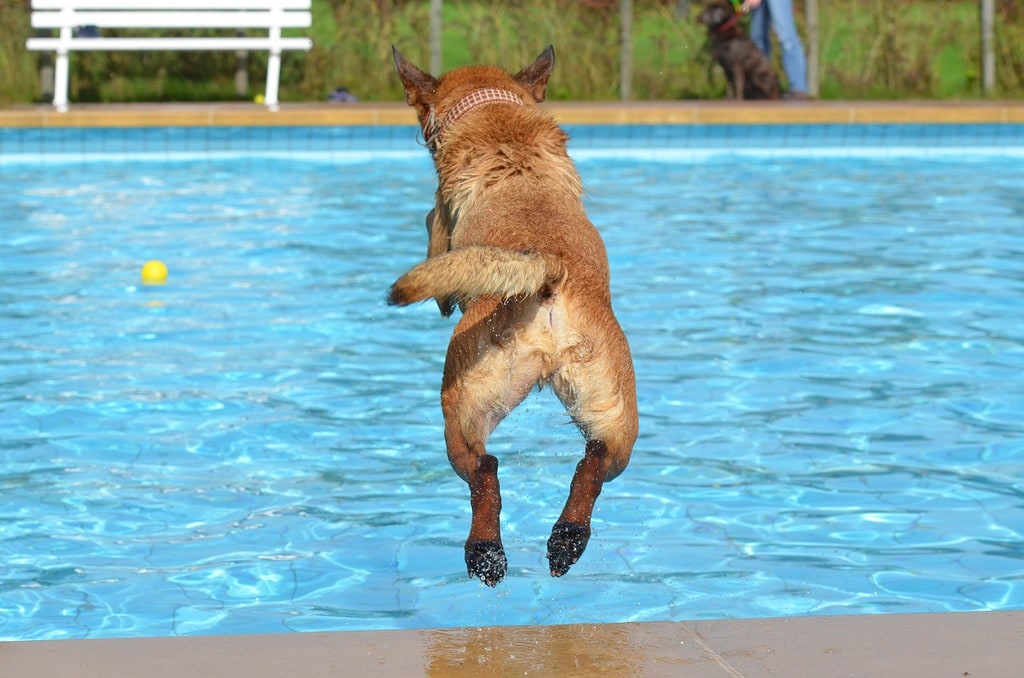If you spend much time around dogs, you can typically tell what kind of mood they are in based on their jump. Whether out of excitement, anger, or hunger, pet owners might want them to avoid jumping for many reasons.
So how do you train a dog not to jump? In order to train a dog not to jump, the steps you will need to take include establishing control, utilizing key commands such as “Sit’ or “Up,” reducing emotional attention, and promoting obedience. The training process will require reinforcing appropriate behavior and rewarding such behavior with incentives that will create intrinsic motivation within the animal.
Why it’s Necessary to Teach Your Dog Not to Jump
Taking the initiative to put an end to your pup’s behavior can begin at any stage in their life. With these steps on how to train a dog not to jump, you can throw the “You can’t teach an old dog new tricks” mindset out the window.
Training a dog not to jump is easier said than done, but it is not impossible with determination, consistency, and a handful of doggy treats. Whether a jump is meant as a greeting or an attack, it is not hard to understand why an owner would want to take control of and restrain this behavior.
Not only can it be a safety concern for those being jumped on, but it can also be viewed as rude and lacking in common courtesy. The last thing most owners want is for their guests to feel threatened or uncomfortable because of an undisciplined dog.
Understand Why Your Dog is Jumping

The most common reasons why dogs jump include:
Greeting
Jumping up is a natural greeting behavior for dogs. Not only do they greet humans that way, but they also react the same way to other dogs.
You need to train your dog to greet you and others in a way that is most appropriate for the human species, making sure they know when and when not to on command.
Most dogs sit at home all day and afternoon waiting for their owners to come home and when they finally do, the excitement is so overwhelming they don’t know how else to express themselves but by jumping.
For those who steer clear of canines, they are often left wondering if they are going to be greeted or attacked. Some individuals don’t want to wait around to find out. If you want to better help your casual run-in with strangers or neighbors, consider making some changes to both your lifestyle and that of your dog.
Excitement
The answer as to why your dog is a jumper is not always black and white – there are gray areas that involve the same factors mentioned, plus personality. Do keep in mind that boredom can be a huge factor as well.
When you are gone for the day, or for even an hour, that truly affects them and causes extreme boredom or even separation anxiety. Most dogs sleep their day away, waiting for you to return. Not having anyone to play with or keep an eye on truly makes a big difference in their daily behavior.
To most, their pets are just a small part of their lives but, to a dog, you are their entire world. When you are back into their focus, they cannot contain their excitement, which ultimately leads to such behavior. Over time, your aim should be to get your dog’s jumping under control. One step at a time is all it takes.
Begging
If you know your pet craves food, especially if they’ve gotten used to the idea of table food, you might have a beggar on your hands. Have you ever noticed the intense drooling stare dogs give when you’re eating?
If that wasn’t unpleasant in itself, it could develop into more aggressive behavior involving jumping.
Dominance
Since dogs do not have the language skills to properly convey their feelings, they rely on their body language to speak for them. You can notice the difference between a jump of dominance over a jump of joy if there is licking involved.
If your dog is not licking you, but you find them standing with their paw on your chest, or pushing you backward, you can guarantee you they are trying to gain dominance over you.
Whether your pup is jumping to beg for food, attention, or a toy, they are most likely jumping up. They may leap onto your leg or the chair you are sitting on. Some dogs are even relentless enough to jump on the table or counter. Avoid reaching this point by beginning training as early as possible (source).
These understandable problems have a straightforward solution–management and training. The two combined are the perfect duo for eliminating the jumping behavior.
Training helps to control the dog’s jumping, while management reinforces the training. If punishment (i.e., a time out) is necessary, that would also fall under management.
Training Your Dog Not to Jump
Although the answer may seem so simple, implementing training and management actually takes a lot of work.
Owners tend to become easily discouraged if they think that there is an exact science behind training. Unfortunately, in actuality, your dog may or may not willingly go along with your requests.
Take a chance, put your all into it and, hopefully, the two of you will grow and learn from this bonding experience.
Put down your phone, close up your computer, and let’s throw away the “doggy don’t” devices (shock/vibration collars and bark controllers) and get started on some real, one-on-one pup training time.
Related Read: How to Teach a Dog to Come When Called, learn the basics of training.
Stop Your Dog From Jumping: Three Clear Steps

The first order of business is to switch into and maintain your new “teacher mode” persona so that your dog can sense that you expect them to take you seriously.
Most importantly, remain consistent. When dogs fall out of a routine or become unfamiliar with anything, they are more likely to pay closer attention so they can understand and adapt to the changes around them.
Encourage changed behavior as a positive journey while constantly reassuring them you will support them every step of the way.
Step 1: Establish Clear Commands & Dominance
The “Up!” Command. The only Acceptable Time to Jump
The word “Up” will become a crucial word in your vocabulary when conversing with your dog. Jumping will only be accepted if you’ve given the command “Up.” If you are not asking them to jump, refrain from saying the word entirely.
You might find it best to associate a certain gesture when saying the word. You could put your hand in the air or point a finger towards the sky.
A gesture might help them better associate the action, and they will soon come to realize they are only allowed to jump upon being asked.
The “Sit” Command
When you are not using the word “Up,” your second word of choice will be “Sit.” This word will become your new best friend in the midst of training. Utilize the word for everything, even situations that do not pertain to jumping (source).
A proper sitting position is when their rump is 100% connected to the floor. When fully sitting, praise them, give a few pets, and toss them a treat if you have one handy. If they are not completely touching the floor, repeat the command or just wait and make it clear they will not receive a treat until they do so.
Doing so will get your dog into the habit of knowing that he or she must sit before anything transpires. If they need to go out, they must sit first before you retrieve their leash.
If they want a treat, they must sit first, and so on. You want to get them into a solid routine and, to do so, you must engage them in loads of repetition.
Not only will doing so strengthen the bond between the two of you, but it will also provide your dog with an outlet for their energy. Dogs are eager to accomplish tasks and are innocently looking for any reason to interact with their owner.
When establishing dominance, attempt training that makes it clear to your pup that you come first, and they are second. Examples would include training them to sit and wait for you to enter a room before they do so, have your dog sit and wait for their food until you say so, and work on having them back up every time you step forward in their direction (source).
Step 2: Reduce the Emotional Attention at First
When you walk in the door, reduce the emotional attention you give your dog and ignore them until they are calm (source).
What was once undivided attention with loads of affection will now need to be lowered. The more attention you provide, the more love and excitement they will shower you with. Avoiding eye contact, touching, or speaking to them will cause them to notice your disapproval.
Although it might be hard for you to adapt to the change, you need to avoid feeding into the behavior. Even when you say “sit,” avoid making eye contact when the behavior is not appropriate while giving the appropriate hand signal to get them to do so.
When the dog jumps, be sure to gently push them off and repeatedly say, “No,” in a stern tone of voice. Repetition is necessary for them to associate the word with the action.
When they are constantly reminded of how their behavior draws negative reactions from you, they will eventually learn to either stop or keep it to a minimum. Most breeds are sensitive to touch as physical contact is rewarding.
Dogs love the feeling of accomplishing something, so if you make the notion clear that you will not address them until all of their paws are on the floor, or if the jumping stops, etc., then they will be excited to complete the task because they are aware a reward (your attention) is soon to come.
Rather than demanding they settle down, try asking your dog to sit down. The act of sitting will help them to settle down.
If your dog is just too rambunctious, and neither of these first two tips works, don’t get discouraged. When you come home, as soon as your dog begins to leap for joy, walk out of the room and close the door behind you.
Put your dog in a timeout for a few seconds to a minute, walk back in, and repeat the steps until he realizes that jumping when you walk through the door is not okay. Don’t forget to reward your dog when you can. Also, keep treats with you or outside the door, and reward your dog when he is not jumping.
Step 3: Reinforce Positive Behavior with Rewards
Always keep treats on hand. Whether they are the healthy snacks, the meaty snacks, or a bone, as long as you are rewarding your pups for good behavior, it should eventually click in their minds that what they are doing is right. If they want more treats, they have to continue the same behavior.
Although the steps may seem minimal, don’t be fooled. There is, in fact, a lot of work within each step that can’t be achieved overnight.
Your dog might be an easy case and, if so, there are simple solutions. Be sure your pup is getting plenty of sleep and exercise. Loads of exercise will keep their excitement at bay for the majority of the day if done consistently (source).
Believe it or not, for some dogs, the simple act of holding something in their mouth distracts them from jumping. Whether a toy, a bone, or a treat depends on the animal. Keep them near the door and as soon as you walk in, hand it to them for an immediate distraction from jumping.
For a quick way to fix it, here’s a short video:
What Most Pet Owners Don’t Realize
Not all dogs are the same but do keep in mind that yelling can also be mistaken as playful behavior.
An alternative method would be to completely pay them no mind until they have calmed down.
This tactic is not as cut and dry because some dogs will assume you are not paying attention or just oblivious, but for the coachable dogs, they will understand that their behavior will not be tolerated until they are completely at a rest.
What Not To Do:
- Do not reward your dog when they jump.
- Do not get frustrated or overwhelmed by the process.
- Do not yell at or hit your dog. This may lead to confusion and longer turnaround time.
- Do not rush the process
Using positive reinforcement while they are jumping will only prolong the training process and will ultimately leave them feeling confused. Losing control of your own emotions through this journey will set you back to square one. Keep positive, have patience, and the rest will fall into place on its own.
If you are interested in learning how to train your dog in other situations, following the same tips and tricks should produce the desired result. Even under special circumstances, you can use the same bottom-line training, just with personalized twists to better help your dog adapt to the situation at hand.
Whether around guests in your home or strangers on the street, keep them on a short leash or maintain a safe grip on their collar. If your dog does not react negatively when walking past them, reward his behavior.
Yes, this means carrying tons of little treats in your pockets. If your dog jumps on the door when you’re on your way to let them outside, back away from the door and command them to sit. Until your pup does so, you must keep that same stern persona mentioned at the beginning of this article.
Read here for an article on what you should do before giving your dog a treat.
Rushing your training journey is also the last thing you want to do. Just like anything in life, once the process is rushed, the level of quality decreases. If you are rushing in your dog’s process, you are the unhealthy factor in this training session.
To avoid rushing, keep calm and be patient. Just like human children, everyone progresses at their own pace. A change in behavior is coming but in due time. You want your journey to be natural so that they fully grasp the concept and maintain it as part of their lifestyle.
Final Thoughts
You will learn a lot about yourself and your dog during your training journey. Over time, not only will your bond be stronger, but so will your sense of discipline. Expect for your dog to have more respect for you and take you more seriously.
Unfortunately, not every dog will adapt to changes as quickly as others, but it is a valuable learning process for both the dog and the owner. Avoid being ‘that owner’ with a leaping dog who scratches guests or dirties their clothing. Happy training!


0 Comments